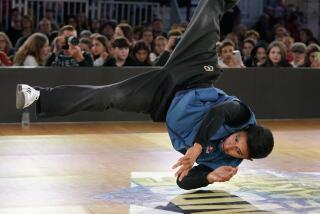Sportclimbing Makes Ascent in U.S. Despite Wall of Fears
- Share via
COLLEGE PARK, Md. — Rock climbers are always looking for a good crack to exploit. Now they’ve found one that could split their sport right down the middle, maybe for the better.
A new spectator game called sportclimbing made its East Coast debut here last weekend, with 106 competitors from as far away as California venturing to this Washington suburb to tackle a four-sided, 40-foot-high wall of plywood and bolted-on footholds at the Springstone ’89 Sportclimbing Competition.
The spectacle that resulted “is like a commercialization of our sport, so to speak,” said Bob Horan of Boulder, Colo. “The companies love it,” he said, citing the shoe, climbing-harness, hardware and rope manufacturers who turn up to sell gear as competitions such as Springstone spread across the country. The shows already are booming in Europe, where they originated, Horan said.
But do traditional U.S. climbers, more accustomed to the rigorous challenges and soothing solitude of the mountains, love it, too?
Not Madeleine Carter of Washington, a stalwart in the Potomac Appalachian Trail Club’s mountaineering section, who wound up second in the women’s recreational division here after her first assault on a man-made wall.
“I don’t like spectator sports,” she said. “The whole reason I climb is because it’s an individual, noncompetitive sport. This is just the opposite.”
She entered Saturday’s competition, along with 15 other women, only because “we felt there should be some women in it.” But by the time she was 10 feet up the wall, “I was having fun,” she acknowledged.
She and most others among the 400 to 500 on hand Saturday said what they found in a jammed parking lot definitely was not mountaineering, where the rewards are more aesthetic than athletic. It wasn’t even rock-climbing.
“This takes one small aspect of rock-climbing--gymnastic ability--and turns it into a competition and puts it on stage,” said Dan Lewis of Washington. “I’m enjoying it, but I wouldn’t trade” for the real thing.
His stage on Saturday was a dark blue, home-made monolith of 4-by-4-foot plywood sheathing, its slick, vertical surfaces studded with concrete-colored holds of dinner-plate size and smaller, arrayed so as to make climbing to the top a feat of considerable skill. The routes were so hard that of the elite men only one made it to the top, winner John Bercaw of Bethesda, Md.
But unlike mountaineering up a route of similar difficulty, there was no danger. Every climber was hooked to a safety rope from the time he made his first step, and when each fell, as almost all did, the descent was quickly arrested by a belayer below.
No small comfort. “On a mountain,” said Nancy Prichard of Collingswood, N.J., who was third in the elite women’s category, “you need good judgment, a lot of common sense, safety training. Here, you can go out, you know you’re not going to get hurt, you get a good workout and you can go into town afterwards and have a good dinner and a cold one. You know you’re not going to end up on a ledge all night in a snowstorm.”
Sportclimbing came of age in the United States this spring, when a competition at Snowbird, Utah, made national network TV. French climbing superstar Patrick Edlinger claimed the $3,000 first prize there, and a new TV diversion was born.
The College Park competition, first ever in the East on a man-made wall, was the brainstorm of a few PATC types including Stewart Pregnall, who defended the concept.
“It provides the perfect outlet for a new direction for our sport,” said Pregnall. He said setting up a competition for spectators in the wild is nearly impossible. Furthermore, “A lot of climbers are doing very unethical things (in the wilderness) in order to keep climbing harder and harder routes. They’re chipping rocks (to make holds), gluing holds on, and it’s all to get their names in the magazines” for conquering previously unclimbed routes.
With sportclimbing, said Pregnall, you can set harder and harder routes without harming anything, and the best climbers can get the recognition they deserve, while at the same time demonstrating to others what they’re doing.
To many, sportclimbing on artificial walls is the future of rock-climbing, especially now that it’s been approved as a demonstration sport for the 1992 Olympics at Barcelona. Jesse Guthrie of Nederland, Colo., said he is aiming for the Olympics and will have to all but abandon climbing real stone in order to get there. “It’s just totally different,” he said. “To compete, you’re going to have to train in the gym,” he said, “and train hard.”
More to Read
Sign up for The Wild
We’ll help you find the best places to hike, bike and run, as well as the perfect silent spots for meditation and yoga.
You may occasionally receive promotional content from the Los Angeles Times.






